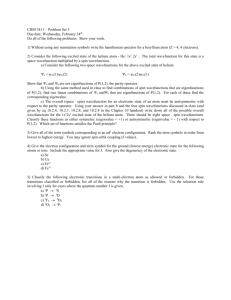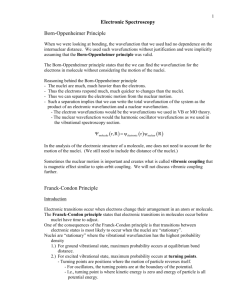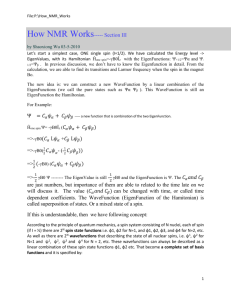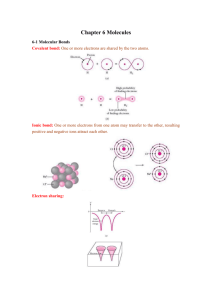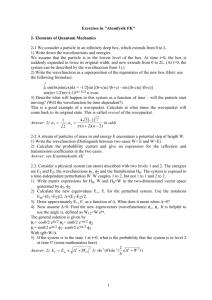Exam2
advertisement
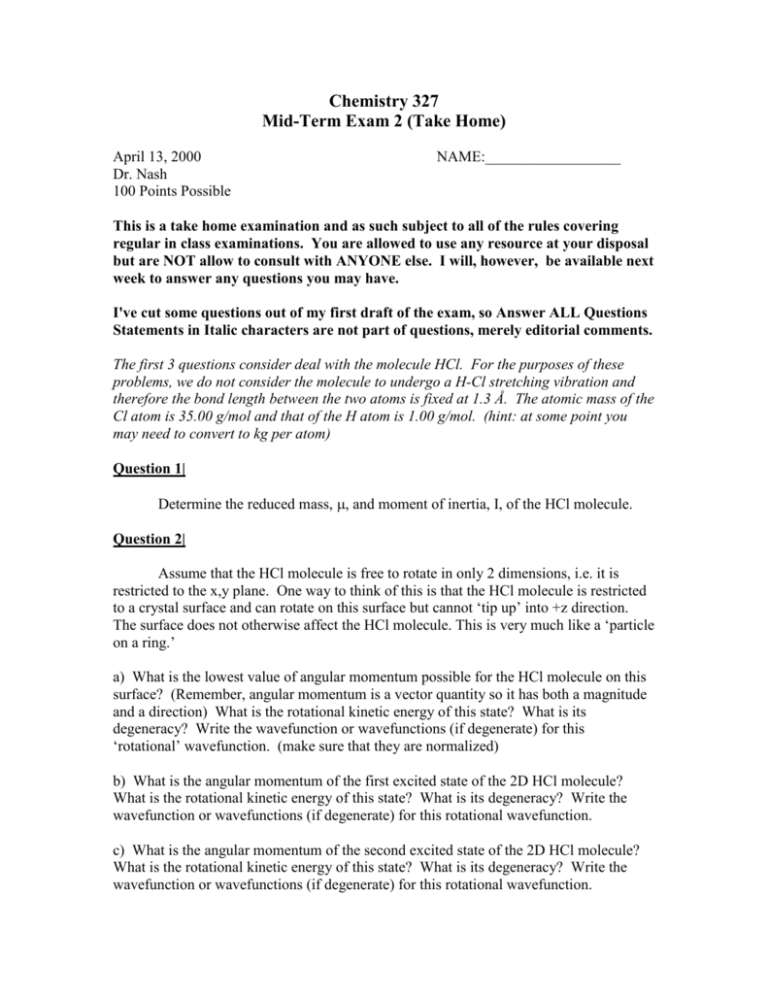
Chemistry 327 Mid-Term Exam 2 (Take Home) April 13, 2000 Dr. Nash 100 Points Possible NAME:__________________ This is a take home examination and as such subject to all of the rules covering regular in class examinations. You are allowed to use any resource at your disposal but are NOT allow to consult with ANYONE else. I will, however, be available next week to answer any questions you may have. I've cut some questions out of my first draft of the exam, so Answer ALL Questions Statements in Italic characters are not part of questions, merely editorial comments. The first 3 questions consider deal with the molecule HCl. For the purposes of these problems, we do not consider the molecule to undergo a H-Cl stretching vibration and therefore the bond length between the two atoms is fixed at 1.3 Å. The atomic mass of the Cl atom is 35.00 g/mol and that of the H atom is 1.00 g/mol. (hint: at some point you may need to convert to kg per atom) Question 1| Determine the reduced mass, , and moment of inertia, I, of the HCl molecule. Question 2| Assume that the HCl molecule is free to rotate in only 2 dimensions, i.e. it is restricted to the x,y plane. One way to think of this is that the HCl molecule is restricted to a crystal surface and can rotate on this surface but cannot ‘tip up’ into +z direction. The surface does not otherwise affect the HCl molecule. This is very much like a ‘particle on a ring.’ a) What is the lowest value of angular momentum possible for the HCl molecule on this surface? (Remember, angular momentum is a vector quantity so it has both a magnitude and a direction) What is the rotational kinetic energy of this state? What is its degeneracy? Write the wavefunction or wavefunctions (if degenerate) for this ‘rotational’ wavefunction. (make sure that they are normalized) b) What is the angular momentum of the first excited state of the 2D HCl molecule? What is the rotational kinetic energy of this state? What is its degeneracy? Write the wavefunction or wavefunctions (if degenerate) for this rotational wavefunction. c) What is the angular momentum of the second excited state of the 2D HCl molecule? What is the rotational kinetic energy of this state? What is its degeneracy? Write the wavefunction or wavefunctions (if degenerate) for this rotational wavefunction. d) What is the energetic difference between the ground and first excited rotational states? What is the energetic difference between the first and second excited rotational states? e) Calculate the wavelengths of the photons required to effect each of the transitions described in part d. f) Why are these rotational energies quantized in the first place? Question 3| Free at last, our intrepid HCl molecule is liberated from the crystalline surface. It is now free to rotate in 3 dimensions. This is very much like a ‘particle on a ball.’ a) What is the lowest value of angular momentum possible for the freely rotating HCl molecule? What are the possible ‘orientations’ of this angular momentum vector along the z-axis? What is the rotational kinetic energy of this state? What is its degeneracy? Write the wavefunction or wavefunctions (if degenerate) for this ‘rotational’ wavefunction. (make sure that they are normalized) b) What is the angular momentum of the first excited state of the 3D HCl molecule? What are the possible ‘orientations’ of this angular momentum vector along the z-axis? What is the rotational kinetic energy of this state? What is its degeneracy? Write the wavefunction or wavefunctions (if degenerate) for this rotational wavefunction. c) What is the angular momentum of the second excited state of the 3D HCl molecule? What are the possible ‘orientations’ of this angular momentum vector along the z-axis? What is the rotational kinetic energy of this state? What is its degeneracy? Write the wavefunction or wavefunctions (if degenerate) for this rotational wavefunction. d) What is the energetic difference between the ground and first excited rotational states? What is the energetic difference between the first and second excited rotational states? e) Calculate the wavelengths of the photons required to effect each of the transitions described in part d. f) Why are these rotational energies quantized in the first place? Okay, we’re done with HCl, we continue. Question 4| Electrons behave as if they were tiny ‘particle on a ring’ because they have their very own intrinsic angular momentum that we call spin. This kind of angular momentum, however, is quite different than orbital angular momentum, for instance, because it can occur in half-odd integer multiples of , i.e 1/2 , 3/2. etc. Make a drawing that explains how the particle on a ring molecule can be used to describe this type of weird angular momentum. Consider the H atom Question 5| (a) Write the full (space and spin parts) wavefunction or wavefunctions (if degenerate) for the ground state of the H atom. What are the spatial and spin degeneracies of this state. What ‘term symbol’ (e.g. 1S) would we apply to this state? (b) Write the full (space and spin parts) wavefunction or wavefunctions (if degenerate) for the lowest excited 2S state of the H atom. What are the spatial and spin degeneracies of this state. (c) Write the full (space and spin parts) wavefunction or wavefunctions (if degenerate) for the lowest excited 2P state of the H atom. What are the spatial and spin degeneracies of this state. (d) What are the energies of the 2S and 2P excited state of the H atom (calculate them) from parts b) and c). How do these energies compare, what is perhaps unique about this result? (e) Draw qualitative radial orbital and probability density plots of for the electrons in the states described in parts b) and c). Now think about He and other multi-electron atoms Question 7| What is a correct statement of the Pauli exclusion principle and what does that have to do with Slater determinants? Question 8| (a) Write the full (space and spin parts) wavefunction or wavefunctions (if degenerate) for the ground state of the He atom. What are the spatial and spin degeneracies of this state. What ‘term symbol’ (e.g. 1S) would we apply to this state? (b) Write the full (space and spin parts) wavefunction or wavefunctions (if degenerate) for the 2 lowest excited states (1S and 3S) of the He atom. What are the spatial and spin degeneracies of these states? What are the relative energies of these states? (c) The figure attached is a qualitative representation of the absorbtion spectrum for the excitation of the He atom from its ground state to the two lowest excited states. That is, this spectrun arises from the 1s2---> 1s12s1 excitations. What would this diagram look like if the spectrum were take in a magnetic (be sure to label the peaks according to the state that gives rise to it) (d) Write the full (space and spin parts) wavefunction or wavefunctions (if degenerate) for the next two excited states of the He atom which arise from the 1s1 2p1 configuration. What are the spatial and spin degeneracies of these states? (e) Predict what the spectrum would look like arising from the 1s2---> 1s12p1 excitations in both the presence and absence of a magnetic field? (draw it) This next question is probably the hardest one, especially the last part. I expect questions. Question 9| What electronic states arise from the 1s2 2s2 2p2 electronic configuration of C? What are their spin and spatial degeneracies? How many Slater determinants are needed to describe the 1D state of this atom? Write them, and don't worry about electrons in closed shells. What are the ML values associated with each of these groupings of Slater determinants? (use the symbols 2p0, 2p1, 2p-1 to represent the three 2p spatial orbitals which have varying ml values.) Molecules, Finally Question 10| Write the ground state wavefunction for the H2 under the valence bond formalism, molecular bond formalism, and Heitler-London formalism. Describe the strengths and drawbacks of each and explain how the concept of ‘configuration interaction’ is related to the last of these formalisms. Question 11| Do the same thing for the first two excited states of H2 (which are dissociative). Do you see any other drawbacks to the use of the valence bond wavefunction for describing these excited states? Predict what a qualitative excitation spectrum of H2 would look like in the both the absence and presence of an external magnetic field. Question 12| Consider HCl again, write valence bond, molecular orbital and configuration interaction wavefunctions for the ground state of the molecule. Why is the use of configuration interaction wavefunctions important for the very polar HCl molecule? Write wavefunctions for the lowest two excited states (both singlet and triplet) as well. For convenience, disregard electrons in nonbonding orbitals such as the Cl 3px and 3py and focus on those involved in bonding, Cl 3pz and H 1s. (by convention, the z axis is usually taken as the intermolecular axis of the molecule) Question 13| Write a MO wavefunction for the ground state of the H3+ molecular ion. What is the degeneracy of this state (both spin and space). Write MO wavefunctions for the singlet and triplet excited states and describe their degeneracies. Using this ion as an example and using appropriate diagrams, explain the origins and differences between fluorescence and phosphorescence.
